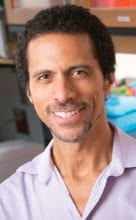A single laboratory is a lot to manage, yet Erich Jarvis recently moved to New York from Duke University—where he had been a faculty member in the neurobiology department since 1998—to set up four labs. His primary lab at Rockefeller University, devoted to studying the neurogenetics of language, will continue to attempt to genetically engineer vocal-learning circuits in species that don’t possess such a function. It’s located in the same building where Jarvis worked as a graduate student and postdoctoral fellow. Also at Rockefeller, he is setting up a vertebrate genomics lab, along with Olivier Fedrigo, to co-lead the vertebrate Genome 10K and the Bird 10,000 Genomes (B10K) Projects. The third Rockefeller-affiliated lab, located at the university’s field research center in upstate New York, will house a large transgenic bird colony. The fourth lab, at New York City’s Hunter College, will study language function homologies across species, including humans. Jointly with Rockefeller University and Hunter College, Jarvis will also help develop “a program for underrepresented minority students to come and do year-long work in Rockefeller laboratories and in which Rockefeller graduate students and postdocs get experience teaching undergraduates in Hunter courses,” he says.
Jarvis was trained in molecular biology in Rivka Rudner’s lab at Hunter and began his neuroscience career at Rockefeller University in Fernando Nottebohm’s group, using songbird communication as a model system to dissect the molecular biology of speech and vocal learning in the brain. “Rockefeller was a place where I had a lot of scientific freedom. The philosophy there is if there is a high probability of an experiment working, then you’re not doing the right experiment, and if it has a high probability of failure, then it could make a big impact in science. I am looking forward to that scientific environment, which is hard to find. And I am looking forward to being closer to my family. What I am not looking forward to is the car noise, the pollution, and the cold weather,” says the native New Yorker.
The full article is available at The Scientist.


